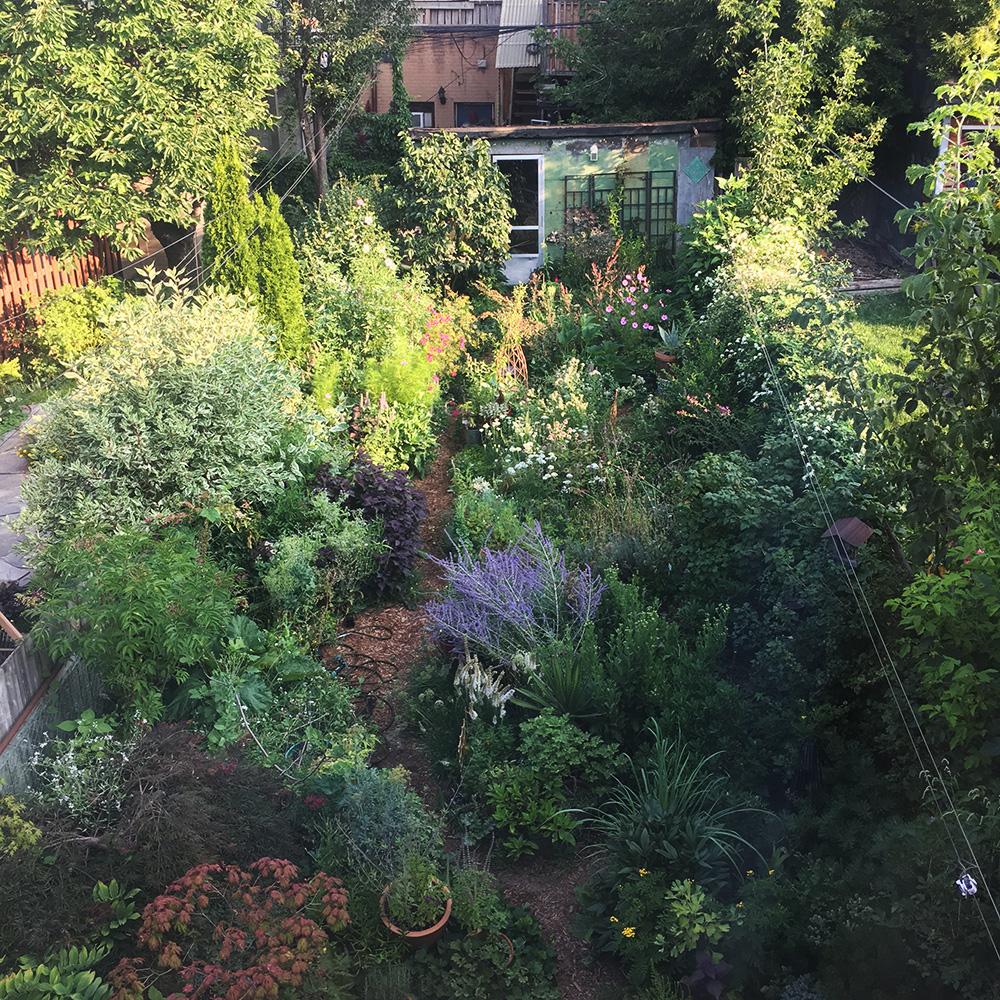
“Gardening is civil and social, but it wants the vigor and freedom of the forest and the outlaw.” – Henry David Thoreau
Here is my garden this morning, August 15, 2018. This may be the most intentionally wild it has ever been. I use the word “intentionally” here, because in the years I was very ill it had a look that may have been interpreted as wildness, when it was really neglected and damaged. This is not the same thing, but there is confusion between the two because to many, wildness is unwanted and therefore IS neglect.
I’ve long considered my gardens to be working spaces: working for pollinators and critters; working to be a somewhat balanced ecosystem (human ego gets in the way of achieving real balance); working to produce food, medicines, dyes, seeds, etc. Some of these intentions and end products require plants growing to stages that they don’t often reach when we garden for aesthetic only. For example, I used to cut my mint plants back fairly vigorously. But now that I want them in bloom for making a hydrosol, they tend to sprawl, dance, and breach the confines of the space I provide. Such a working garden also means growing wilder plants and species that do not stay compact or polite in their form. This is one reason why breeders produce for compactness and tight form. We want plants that stay constrained and are easily controlled. Wilder species aren’t about that. They push themselves outward, upward, and beyond. They tend to grow into strange and tentacled beasts with a vigour that can be overwhelming and I imagine must feel like downright aggression to those who prefer an orderly space.
While I am an artist at heart, and aesthetics do matter, by late summer there is no hope of falling into line with what most would consider a “proper” garden. It’s hot, so very, very hot, and for the sake of my health, being out in the garden is restricted to a small, cooler window at the end of the day. At this point in my life I’m cool with my non-conforming garden. In fact, I’ve worked hard to get here. I am proud of this little piece of earth and have mostly purged myself of many of the sorts of outside expectations and values that would have me tame the wildness of my garden. It blows my mind some days when I head out into this space. It/they/she/kin is alive. There are things happening there that surprise me. It carries a presence that none of my other gardens have before and that presence is powerful. Some days that power scares me and I often ponder what that fear is about and how it has driven us away from our own beautiful, powerful wildness to a more constrained and controllable society of peoples who are disconnected, desperate and grasping at all of the wrong things, hurting deeply, and unable to find the wholeness we need in order to heal.

A spread from my book, Grow Curious: Creative Activities to Cultivate Joy, Wonder, and Discovery in Your Garden
I have come to see the wildness of this space as an extension of my own wildness. I first wrote about this five years ago, but back then I used the word “messiness.” Because this is how our culture sees wild spaces: messy and out of control. Incidentally, it is also how it sees women, especially those of us who are aging and/or growing into our own power and no longer working so hard to please, perform, and conform. It wasn’t long after I started confronting my feelings about messiness that I realized what I was seeking, what I needed, was an unleashing of my own inner wildness and that my education and transformation — learning how to let go, find, and hold that power — was happening through my work with the garden.
As I work on the garden, the garden works on me.
Your garden looks GREAT. Your hard work is paying off 100%.
Enjoy it to the fullest
As you say, as I grow older, more self-possessed & confident in who I am I care less and less about conforming. I see how that can extend to one’s garden. Here’s to the external and internal wildness
Awesome read, will recommend your ebook to my mother next summer has she likes to garden.
Your garden is glorious! truly beautiful!
I checked out your Instagram, thank you for the book recommendations about childhood trauma.
I love your jungly garden. It looks like a healing paradise. I am leaving a similar garden with a wild aesthetic and must turn into conventional landscaping for my house to sell. Heartache. I hope you never have to leave your life-filled haven.
I came here through A Way to Garden, and have to say how much I love this post. I also grow for food, medicine, dye, seeds, as well as beauty, and continue to learn about all of these. A few years ago, I played with making a couple of hydrosols, and you’ve inspired me to try it again. I appreciate your thoughts on aging, wildness, and power, and look forward to future posts.
I was personally never a fan of these too organised gardens most people have. It looks nice to see something like that in a park or a community garden, but for my personal backyard I prefer a more domestic environment. I don’t let it overgrow with weeds of course, but I stick to a more natural and close to nature look. Every tree has its original shape, the flowers are not arranged by colour and the garden table and chairs are usually dusty.